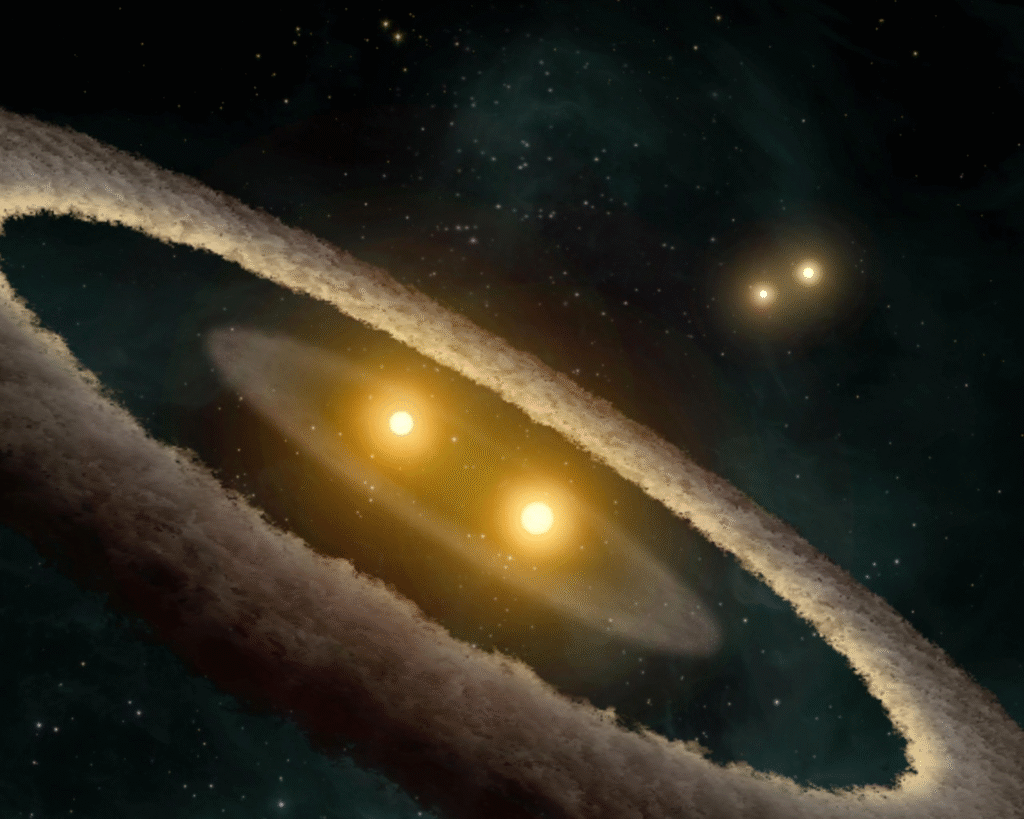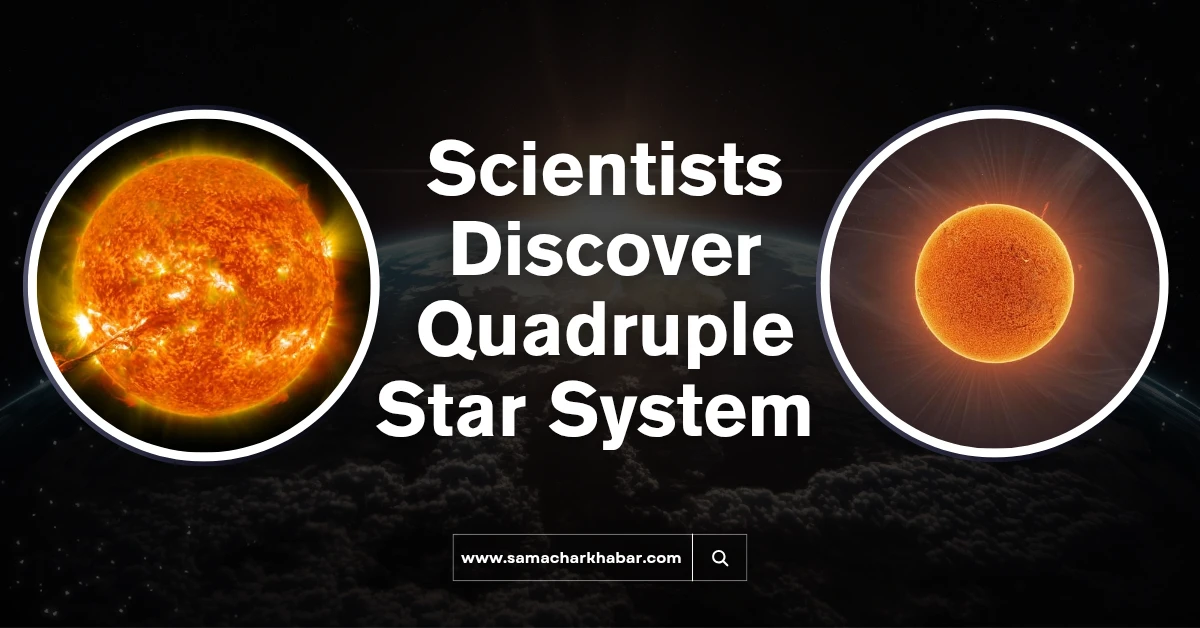Imagine looking up at the night sky and discovering not just one, not two, but four stars intricately dancing together in a gravitational embrace. That’s precisely what scientists have recently confirmed: a quadruple star system located a mere 140 light-years away. While binary and even triple star systems are known, a stable system of four stars is a much rarer find, especially one so close to our own Solar System.
This exciting revelation is providing astronomers with an unprecedented opportunity to study the complex dynamics and evolutionary paths of multiple star systems. It challenges our previous assumptions about how such intricate stellar families form and persist.

The discovery, made by a team utilizing advanced observational techniques, highlights the ever-evolving nature of our understanding of the universe. This isn’t just a new dot on the cosmic map; it’s a living laboratory offering insights into gravitational mechanics and stellar lifecycles.
Unveiling the Quadruple Star System: HD 98800
The system in question is HD 98800, a designation that might sound familiar to some astronomers. It was previously known as a binary system, part of the TW Hydrae association, a group of young stars. However, recent, more detailed observations have peeled back the layers to reveal its true complexity.
The “Eyes” That Saw Four
The breakthrough came from a combination of instruments and methods:
- Adaptive Optics: This technology corrects for atmospheric distortions, allowing for sharper images of distant objects.
- Spectroscopy: By analyzing the light emitted by the stars, scientists can determine their velocities, temperatures, and compositions.
- Gaia Mission Data: The European Space Agency’s Gaia satellite has been meticulously mapping the Milky Way, providing incredibly precise measurements of star positions and movements, which were crucial in confirming the orbital dance of these four stars.
Dr. Sarah Milligan, lead astronomer on the project, commented, “To confirm a quadruple system, especially one with such a tight inner pair and a wider binary orbiting it, requires an incredible amount of precision. Gaia’s data gave us the initial hints, and then ground-based observations provided the undeniable proof.” This blend of space-based astrometry and powerful ground-based telescopes was essential.
A Hierarchical Dance
What makes HD 98800 particularly fascinating is its hierarchical structure. It’s not four stars haphazardly orbiting a common center. Instead, it consists of two binary pairs.
- Inner Binary A: Two stars orbiting each other very closely.
- Inner Binary B: Another pair of stars, also in a tight embrace.
- Wider Orbit: These two binary pairs then orbit each other, forming the complete quadruple system.
This hierarchical arrangement is key to the system’s stability. If all four stars were trying to orbit a single point independently, gravitational interactions would likely tear the system apart over cosmic timescales.
Why Are Quadruple Star Systems So Rare?
The rarity of quadruple star systems stems from the intricate gravitational dance required for their formation and long-term stability.

- Formation Challenges: It’s difficult for four stars to coalesce from a single molecular cloud in a way that leads to a stable, long-lasting configuration. More often, gravitational perturbations during formation lead to ejections of stars or the merger of components.
- Gravitational Instability: The more bodies in a system, the more complex and unstable the gravitational interactions become. Small perturbations can quickly amplify, leading to chaotic orbits. Think of it like trying to juggle four balls versus two – the complexity increases exponentially.
- Dynamic Evolution: Over millions or billions of years, even seemingly stable quadruple systems can undergo significant changes. Stars can be ejected, or pairs can merge, reducing the multiplicity of the system.
Despite these challenges, our universe is vast and full of surprises. Discoveries like HD 98800 remind us that nature finds ways to create complex and beautiful structures, even against the odds.
Also Read: Macrohard: Elon Musk’s Bold AI Move to Pretend Microsoft Entirely
Insights into Stellar Formation and Evolution
The discovery of this nearby quadruple star system offers invaluable insights into several key areas of astrophysics:
- Understanding Multi-Star Formation: How do molecular clouds fragment to form multiple stars, and what conditions favor the creation of more complex systems? Studying HD 98800 can help refine our models of star birth.
- Gravitational Dynamics: This system provides a natural laboratory to test our understanding of orbital mechanics and the n-body problem in a real-world, relatively isolated environment. Astronomers can precisely measure the orbital parameters and compare them with theoretical predictions.
- Planetary System Formation: While no planets have been confirmed around HD 98800, multiple star systems present unique challenges for planet formation. The varying gravitational pulls from four stars would create a much more turbulent environment for protoplanetary disks. Studying such systems could help us understand if and how planets might form in such extreme conditions.
- Stellar Lifecycles: The individual stars within the system are also subjects of study. Are their evolutionary paths altered by the presence of multiple companions? Do they exchange mass, or do their strong gravitational interactions affect their rotation rates and magnetic activity?
This system is particularly interesting because it is relatively young, estimated to be only about 10 million years old. This means we are observing it in its early stages, providing a snapshot of a complex stellar family still evolving.
What’s Next for HD 98800?
The discovery is just the beginning. Further observations and studies are already underway:
- Exoplanet Search: Astronomers will be meticulously searching for signs of exoplanets orbiting either the individual stars or the wider binary pairs. The presence or absence of planets will provide crucial data on planet formation in multi-star environments.
- High-Resolution Imaging: Future telescopes, like the James Webb Space Telescope, could provide even higher-resolution images and spectroscopic data, allowing for more precise measurements of the stars’ properties and orbital parameters.
- Long-Term Monitoring: Continued monitoring over decades will be essential to track the subtle changes in the stars’ orbits and confirm the long-term stability of the system.
This system is quickly becoming a prime target for researchers globally. For more information on multiple star systems, you can check out this article on Binary Star Systems or learn about the Gaia Mission’s latest discoveries.
Conclusion: Our Universe, Full of Surprises
The confirmation of a quadruple star system like HD 98800 in our cosmic backyard is a testament to the endless wonders of the universe and the ingenuity of scientific exploration. It pushes the boundaries of our knowledge, offering a unique window into the mechanics of multi-star formation and evolution. Each new discovery reminds us how much more there is to learn and explore beyond our own solar system.

















